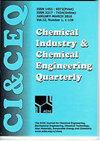Heat transfer studies of Al2O3/water-ethylene glycol nanofluid using factorial design analysis
IF 0.8
4区 工程技术
Q4 CHEMISTRY, APPLIED
Chemical Industry & Chemical Engineering Quarterly
Pub Date : 2021-01-01
DOI:10.2298/CICEQ210125021M
引用次数: 1
Abstract
The experimental study of heat transfer coefficient of nanofluid plays a significant role in improving the heat transfer rate of the heat exchanger. The research was conducted in a natural convection heat transfer apparatus by suspending Al2O3 nanoparticle in a base fluid of Water-Ethylene glycol mixture. The effects of heat input (A), nanoparticle volume fraction (B), and base fluid concentration (C) on experimental heat transfer coefficient (hexpnf) were studied. By the results obtained by MINITDesign software 23 full factorial design matrix, 16 experimental runs were performed with the lower and higher level of input factors. The levels for heat input are 10 and 100 W; nanoparticle volume fraction is 0.1 and 1 volume% and for base fluid concentration is 30 and 50 volume% of Ethylene Glycol in water. From the obtained experimental results residual plots, Pareto chart, contour plot and 3D surface plots were drawn. It can be found from the study that the experimental heat transfer coefficient showed highest enhancement with high level of nanoparticle volume fraction and moderate enhancement with high level of heat input and slight enhancement with base fluid concentration.用析因设计分析研究氧化铝/水-乙二醇纳米流体的传热
纳米流体换热系数的实验研究对提高换热器的换热率具有重要意义。在自然对流换热装置中,将纳米Al2O3颗粒悬浮在水-乙二醇混合物的基液中。研究了热输入(A)、纳米颗粒体积分数(B)和基液浓度(C)对实验换热系数(hexpnf)的影响。根据MINITDesign软件23全因子设计矩阵得到的结果,在不同的输入因子水平下进行了16次试验。热输入等级为10和100w;纳米颗粒体积分数为0.1和1体积%,基液浓度为30和50体积%的乙二醇在水中。根据得到的实验结果绘制残差图、帕累托图、等高线图和三维曲面图。研究发现,高纳米颗粒体积分数对实验换热系数的增强作用最大,高热输入对实验换热系数的增强作用适中,基液浓度对实验换热系数的增强作用较小。
本文章由计算机程序翻译,如有差异,请以英文原文为准。
求助全文
约1分钟内获得全文
求助全文
来源期刊

Chemical Industry & Chemical Engineering Quarterly
CHEMISTRY, APPLIED-ENGINEERING, CHEMICAL
CiteScore
2.10
自引率
0.00%
发文量
24
审稿时长
3.3 months
期刊介绍:
The Journal invites contributions to the following two main areas:
• Applied Chemistry dealing with the application of basic chemical sciences to industry
• Chemical Engineering dealing with the chemical and biochemical conversion of raw materials into different products as well as the design and operation of plants and equipment.
The Journal welcomes contributions focused on:
Chemical and Biochemical Engineering [...]
Process Systems Engineering[...]
Environmental Chemical and Process Engineering[...]
Materials Synthesis and Processing[...]
Food and Bioproducts Processing[...]
Process Technology[...]
 求助内容:
求助内容: 应助结果提醒方式:
应助结果提醒方式:


